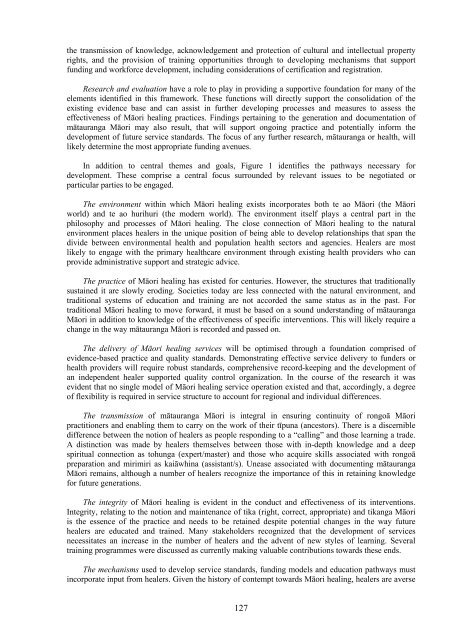traditional knowledge conference 2008 te tatau pounamu
traditional knowledge conference 2008 te tatau pounamu
traditional knowledge conference 2008 te tatau pounamu
You also want an ePaper? Increase the reach of your titles
YUMPU automatically turns print PDFs into web optimized ePapers that Google loves.
the transmission of <strong>knowledge</strong>, ac<strong>knowledge</strong>ment and pro<strong>te</strong>ction of cultural and in<strong>te</strong>llectual propertyrights, and the provision of training opportunities through to developing mechanisms that supportfunding and workforce development, including considerations of certification and registration.Research and evaluation have a role to play in providing a supportive foundation for many of theelements identified in this framework. These functions will directly support the consolidation of theexisting evidence base and can assist in further developing processes and measures to assess theeffectiveness of Māori healing practices. Findings pertaining to the generation and documentation ofmātauranga Māori may also result, that will support ongoing practice and po<strong>te</strong>ntially inform thedevelopment of future service standards. The focus of any further research, mātauranga or health, willlikely de<strong>te</strong>rmine the most appropria<strong>te</strong> funding avenues.In addition to central themes and goals, Figure 1 identifies the pathways necessary fordevelopment. These comprise a central focus surrounded by relevant issues to be negotia<strong>te</strong>d orparticular parties to be engaged.The environment within which Māori healing exists incorpora<strong>te</strong>s both <strong>te</strong> ao Māori (the Māoriworld) and <strong>te</strong> ao hurihuri (the modern world). The environment itself plays a central part in thephilosophy and processes of Māori healing. The close connection of Māori healing to the naturalenvironment places healers in the unique position of being able to develop relationships that span thedivide between environmental health and population health sectors and agencies. Healers are mostlikely to engage with the primary healthcare environment through existing health providers who canprovide administrative support and stra<strong>te</strong>gic advice.The practice of Māori healing has exis<strong>te</strong>d for centuries. However, the structures that <strong>traditional</strong>lysustained it are slowly eroding. Societies today are less connec<strong>te</strong>d with the natural environment, and<strong>traditional</strong> sys<strong>te</strong>ms of education and training are not accorded the same status as in the past. For<strong>traditional</strong> Māori healing to move forward, it must be based on a sound understanding of mātaurangaMāori in addition to <strong>knowledge</strong> of the effectiveness of specific in<strong>te</strong>rventions. This will likely require achange in the way mātauranga Māori is recorded and passed on.The delivery of Māori healing services will be optimised through a foundation comprised ofevidence-based practice and quality standards. Demonstrating effective service delivery to funders orhealth providers will require robust standards, comprehensive record-keeping and the development ofan independent healer suppor<strong>te</strong>d quality control organization. In the course of the research it wasevident that no single model of Māori healing service operation exis<strong>te</strong>d and that, accordingly, a degreeof flexibility is required in service structure to account for regional and individual differences.The transmission of mātauranga Māori is in<strong>te</strong>gral in ensuring continuity of rongoā Māoripractitioners and enabling them to carry on the work of their tīpuna (ancestors). There is a discernibledifference between the notion of healers as people responding to a “calling” and those learning a trade.A distinction was made by healers themselves between those with in-depth <strong>knowledge</strong> and a deepspiritual connection as tohunga (expert/mas<strong>te</strong>r) and those who acquire skills associa<strong>te</strong>d with rongoāpreparation and mirimiri as kaiāwhina (assistant/s). Unease associa<strong>te</strong>d with documenting mātaurangaMāori remains, although a number of healers recognize the importance of this in retaining <strong>knowledge</strong>for future generations.The in<strong>te</strong>grity of Māori healing is evident in the conduct and effectiveness of its in<strong>te</strong>rventions.In<strong>te</strong>grity, relating to the notion and main<strong>te</strong>nance of tika (right, correct, appropria<strong>te</strong>) and tikanga Māoriis the essence of the practice and needs to be retained despi<strong>te</strong> po<strong>te</strong>ntial changes in the way futurehealers are educa<strong>te</strong>d and trained. Many stakeholders recognized that the development of servicesnecessita<strong>te</strong>s an increase in the number of healers and the advent of new styles of learning. Severaltraining programmes were discussed as currently making valuable contributions towards these ends.The mechanisms used to develop service standards, funding models and education pathways mustincorpora<strong>te</strong> input from healers. Given the history of con<strong>te</strong>mpt towards Māori healing, healers are averse127
















